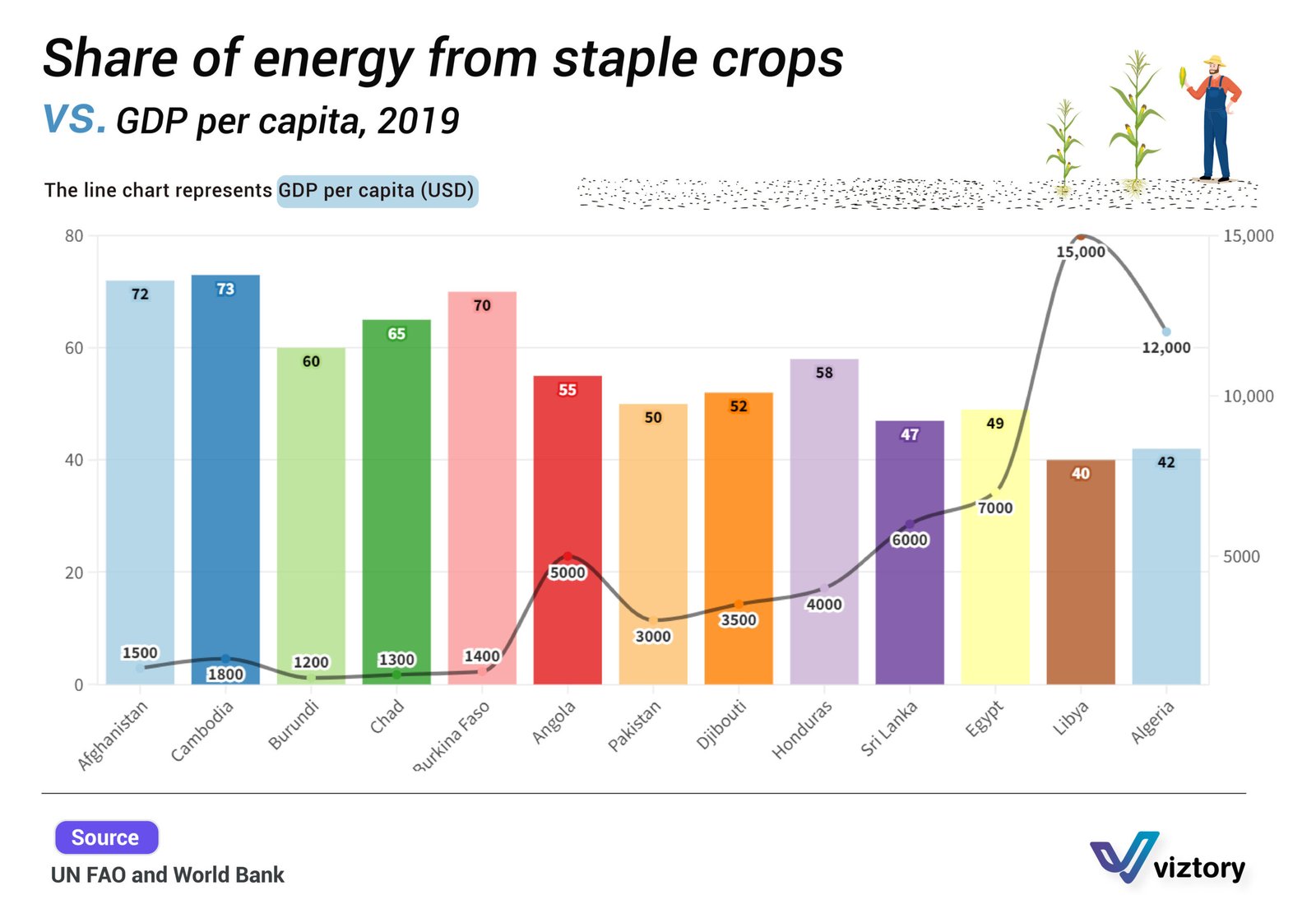Understanding the Role of Staple Crops in Healthcare: A Link to Economic Prosperity
-
Sep, Thu, 2024
Understanding the Role of Staple Crops in Healthcare: A Link to Economic Prosperity
The relationship between diet, economy, and public health has long been a critical topic for policymakers and healthcare professionals. The provided image illustrates the share of energy derived from staple crops across various countries and correlates it with GDP per capita, offering insight into how economic factors influence dietary patterns. As shown, countries with lower GDP tend to rely more heavily on staple crops for their energy intake, while nations with higher GDPs have more diversified diets. This relationship has profound implications for healthcare, as the balance and quality of diets directly impact public health outcomes.
Staple Crops and Their Role in Nutrition
Staple crops, such as rice, wheat, and maize, are fundamental sources of calories, particularly in low-GDP countries. For instance, nations like Afghanistan and Cambodia, with a GDP per capita of $1,500 and $1,800 respectively, rely on staple crops for more than 70% of their dietary energy. While these crops are essential for preventing hunger and malnutrition, an overreliance on them often leads to nutrient deficiencies. Diets based primarily on staple crops may lack diversity, resulting in insufficient intake of essential nutrients such as protein, vitamins, and minerals, which are vital for maintaining health.
In healthcare systems of low-GDP countries, addressing malnutrition and deficiencies caused by a limited diet remains a significant challenge. Diseases such as anemia (due to iron deficiency) and stunting in children (due to lack of essential nutrients) are common in populations heavily dependent on staple crops. These health concerns place an additional burden on already strained healthcare systems, where resources are often limited, and access to healthcare services is inconsistent.
The Healthcare Impact of Diet Diversification
Countries with higher GDP per capita, such as Egypt ($7,000) and Algeria ($12,000), exhibit a lower dependency on staple crops for energy, with percentages closer to 40-49%. This lower reliance on staple crops indicates a more diversified diet, likely including a greater variety of vegetables, fruits, proteins, and fats, which contributes to better overall nutrition and health outcomes. A more varied diet helps prevent the chronic diseases commonly seen in wealthier countries, such as heart disease, diabetes, and obesity. However, it also poses new challenges for healthcare systems in terms of managing the long-term effects of excessive caloric intake and unbalanced diets.
As countries’ economies grow, healthcare professionals must emphasize education around balanced diets. A shift from primarily starch-based diets to those that include processed foods high in fats and sugars can lead to the opposite extreme—overnutrition and obesity. Public health initiatives need to balance the focus between eliminating undernutrition in low-income countries and preventing overnutrition and lifestyle diseases in wealthier ones.
Economic Prosperity and Access to Healthcare
The correlation between GDP per capita and reliance on staple crops is a reflection of broader economic conditions that influence not only dietary habits but also access to healthcare. Countries with lower GDP tend to have weaker healthcare infrastructures, making it difficult to address widespread malnutrition and chronic health issues. The emphasis in healthcare systems in these regions is often on basic survival rather than long-term wellness, as the immediate need to combat hunger and malnutrition dominates public health priorities.
On the other hand, wealthier countries, with more robust healthcare systems, are better equipped to handle a range of health issues, from malnutrition in some communities to chronic diseases caused by dietary excess in others. Governments in higher-income nations must focus on preventive healthcare measures, such as promoting balanced diets and physical activity, to mitigate the risks associated with wealthier lifestyles.
Conclusion
The image illustrates a clear connection between a country’s economic standing and its reliance on staple crops for energy. This relationship is essential for understanding the healthcare challenges that different nations face. In low-GDP countries, the focus of healthcare should be on improving access to a more diverse range of foods to combat malnutrition and nutrient deficiencies. Conversely, in higher-GDP countries, healthcare systems need to address the rise of chronic diseases linked to overnutrition and unbalanced diets.
By recognizing the role that staple crops play in global diets, healthcare systems can better tailor their strategies to address the specific nutritional and health needs of their populations. In doing so, they will be more equipped to create sustainable improvements in public health, both in resource-constrained settings and in wealthier nations.

